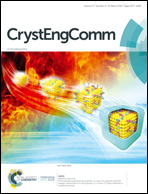Triazine-based molecular glasses frustrate the crystallization of barbiturates†
Abstract
Hydrogen bonding is a key element of supramolecular chemistry and is often used in crystal engineering to direct crystal packing. In particular, systems where motifs with multiple hydrogen (H) bonds are present, such as the donor–acceptor–donor – acceptor–donor–acceptor (DAD–ADA) synthon, can be used to generate various supramolecular architectures. However, H-bonding can also be used to frustrate crystallization if it impedes an efficient molecular packing, instead resulting in glass formation. Herein, triazine-based molecular glass-formers, which can form multiple hydrogen bonds and show outstanding resistance to crystallization, are strategically used to hinder the crystallization of barbiturate derivatives, even in blends with low molar fractions, depending on the structure of the glass-former. Besides the strong DAD–ADA motifs, the molecules can form several sub-optimal motifs that can serve to hinder the crystallization of the barbiturate component during solvent evaporation or cooling. A triazine derivative with a covalently bound barbituric acid moiety was also synthesized, and did also not show any crystallization, showing that the presence of strong and predictable hydrogen bonding motifs does not necessarily contribute to crystallization. Our results highlight molecular design guidelines to hinder the crystallization of a compound, either by covalent functionalization or by blending with a glass-former capable of establishing similar interactions, thus leading to a variety of motifs for glass engineering.



 Please wait while we load your content...
Please wait while we load your content...